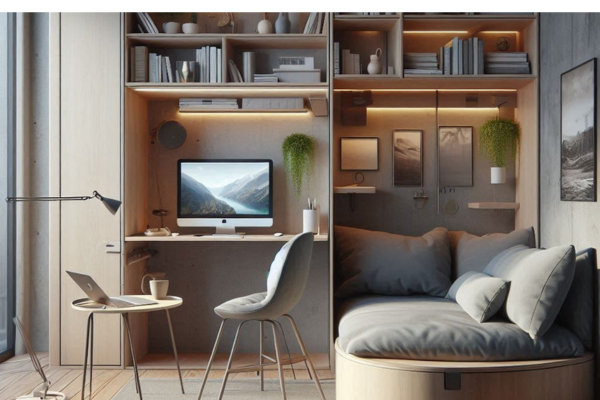In small apartments, natural light isn’t just a luxury—it’s a design asset. Whether you have big, sun-drenched windows or a single east-facing source of light, using daylight effectively can make your home feel brighter, bigger, and more inviting.
In this article, you’ll learn how to make the most of whatever natural light you have to maximize visual space, enhance your decor, and improve your well-being—all without major renovations or expensive upgrades.
1. Understand Your Light Sources Start by observing your space at different times of day:
- Which rooms get the most natural light?
- When does that light hit? Morning or afternoon?
- How does the light change—bright, diffused, or indirect?
Once you understand how natural light flows through your apartment, you can start strategically decorating around it.
2. Use Light-Colored Walls to Reflect Light
Light-colored walls are the most effective tool for bouncing natural light around a room.
Best choices:
- Warm whites for soft reflection
- Soft beige or greige for a warmer tone
- Pale gray or cream for a modern, neutral backdrop
Avoid dark or saturated colors on large surfaces in dim rooms—they absorb light and can make spaces feel smaller.
3. Maximize Window Exposure
Your windows are the main source of natural light—make sure you’re not unintentionally blocking them.
Tips:
- Avoid placing tall furniture directly in front of windows.
- Choose low-profile seating or transparent furniture near windows.
- Use floating shelves instead of bulky units.
- Keep windowsills clear or decorated minimally with light-toned items.
The goal is to keep the view open and unobstructed.
4. Choose the Right Curtains and Blinds
Window treatments can either enhance or block your light. To optimize brightness:
- Use sheer curtains or linen drapes that filter light gently.
- Stick with light colors like ivory, sand, or soft gray.
- Consider roller blinds or roman shades that tuck away fully.
- Use double curtain rods to layer sheers with blackout drapes for flexibility.
Tip: Mount curtain rods slightly above and wider than the window to let in maximum light when open.
5. Reflect Light with Mirrors and Glossy Surfaces
Mirrors aren’t just decorative—they’re one of the most powerful tools for amplifying light in your home.
Ideas:
- Place a large mirror across from or diagonal to a window.
- Use mirrored furniture or frames to bounce light around.
- Install a mirror wall in narrow hallways or small living rooms.
- Choose glossy tiles or backsplashes in kitchens and bathrooms.
Even smaller mirrors can make a big difference when placed strategically.
6. Use Transparent and Light Furniture
Dark, heavy furniture absorbs light and can feel bulky in small spaces.
Instead, choose:
- Glass or acrylic tables
- Light wood tones (oak, birch, beech)
- White or pale upholstery
- Open-frame shelving that allows light to pass through
These elements keep your space airy and open, allowing natural light to travel freely.
7. Choose Light-Enhancing Flooring and Rugs
Your flooring has a huge impact on how light behaves in a room.
Suggestions:
- Opt for light wood or laminate if you’re choosing new flooring.
- Use area rugs in neutral tones like cream, beige, or soft gray.
- Avoid high-contrast dark flooring unless offset by white walls and ceilings.
Rugs also help reflect warmth and define areas without interrupting light flow.
8. Bring in Metallic and Reflective Accents
Just like mirrors, metallic accents help scatter light throughout the space.
Try:
- Brass, gold, or chrome light fixtures
- Silver or gold-framed art
- Decorative trays or bowls with reflective finishes
- Glossy ceramics or glass vases
These small details add elegance while supporting your overall lighting strategy.
9. Use Interior Glass or Open Partitions
If your apartment layout allows, consider using glass dividers or open shelves instead of solid walls between spaces.
Benefits:
- Allows light to travel between rooms
- Maintains visual openness
- Great for studios or open-plan spaces
For renters, a bookshelf divider or curtain partition can achieve a similar result without construction.
10. Incorporate Plants That Thrive in Natural Light
Nothing brings a space to life like natural light and greenery.
Ideal light-loving houseplants:
- Fiddle leaf fig
- Snake plant
- Rubber plant
- Pothos
- Aloe vera
Place them near windows or light-reflective surfaces to brighten up corners and add a vibrant focal point.
11. Don’t Forget the Ceiling
Light bounces off ceilings, too. A bright, clean ceiling can help distribute daylight more evenly.
Tips:
- Stick to white or very pale neutral tones
- Use matte or eggshell finish to reduce glare but maintain reflectivity
- Avoid dark ceiling paint unless you’re creating a cozy, enclosed mood
Consider installing semi-flush light fixtures that help bounce artificial light upward when daylight fades.
12. Highlight Natural Light with Strategic Decor
Let the sunlight become part of your design.
Try:
- Shadow-play decor like cut-out pendant lamps
- Crystal sun-catchers or glass ornaments in the window
- Light-toned art that catches the eye near windows
- Bookshelves or nooks that are intentionally placed in lit areas
This makes natural light an active element of your space, not just a background.
Using natural light to your advantage is one of the most effective—and cost-free—ways to enhance your small apartment. From choosing the right colors and furniture to placing mirrors and plants, small adjustments can yield big results.
Whether you’re decorating a sunny studio or trying to brighten a darker nook, the principles above will help you build a home that feels open, calm, and full of life—all thanks to the sun.

